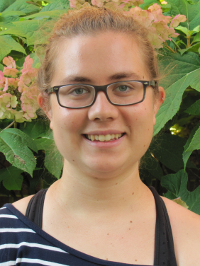2015 SRE Program Participant Profile: VIRGINIA PARKMAN
 |
Hometown: Knoxville, TN |
Why did you apply to the SRE program?
I applied to this program for many reasons. First, I wanted to gain knowledge on the process of mathematical modeling and its connection to biology. Also, I wanted to work on a group project that would help further my understanding of group dynamics and its importance in research. I am also on the fence about what I want to do in the future, whether I will be a teacher or a researcher, and I know this program will help with my decision making process.
What is the purpose of your research?
The purpose of our research is to develop a mathematical model that will show us how fast an outbreak of distemper can travel through a shelter.
What does the research ultimately accomplish? What contributions to science and/or humanity does the research ultimately make?
This research could potentially save hundreds of dogs' lives. With our model, we could potentially show a shelter how to protect their dogs from getting distemper and from spreading the disease.
![]()
You are working in a place that has hundreds of experts in different fields of mathematics and biology that you have the chance to meet. Make sure to take all the opportunities to meet them.
![]()
– Virginia Parkman, SRE participant
Describe a typical day on the job.
A typical day on the job includes a few different tasks. Normally, in the morning, my group meets to discuss our goals for the day. Then, we either work separately or together to achieve those goals. Finally, we meet with our mentors to make sure we are going down the right path.
Tell us something about your field of study we would be surprised to know.
The field of study that I am interested in is mathematics, but more recently I have been interested in cliodynamics, which is the combination of history and dynamics or the evolution of different human histories shown through mathematical modeling. This is a relatively new field of study and not many people know about it.
Do you have an interesting "personal side" to your research experiences?
I have always loved dogs, and when I found out that there was going to be a distemper project, I knew that I wanted to learn about it as much as possible. Also being from the Knoxville area, I knew about Young Williams, and I wanted to learn about how I could help them and shelters like them with disease problems.
What new experiences did you gain that have helped you today?
I have gained so many new experiences. Learning to model has been an integral part of helping along my future. It actually helped me decide that I wanted to continue on to graduate school and look into research during that time.
What advice would you give someone who's interested in/curious about participating in the program?
Make sure to use all the resources provided to you. You are working in a place that has hundreds of experts in different fields of mathematics and biology that you have the chance to meet. Make sure to take all the opportunities to meet them.
Would you recommend our program to others?
Yes, this program has taught me so much, from learning how to code ordinary differential equations to cooperating in a group successfully. This program will help advance your understanding or research and will help you with future research.
For more information about Ginny and her experience as a NIMBioS intern,
read her profile here.
Related Links
Main SRE page
2015 summer program
NIMBioS
1122 Volunteer Blvd., Suite 106
University of Tennessee
Knoxville,
TN 37996-3410
PH: (865) 974-9334
FAX: (865) 974-9461
Contact NIMBioS


